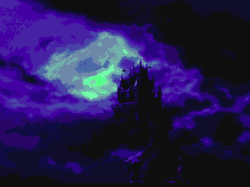 Let’s talk about that thing that all the hep cats know how to do: act like you know what’s up.
Let’s talk about that thing that all the hep cats know how to do: act like you know what’s up.
Today’s game is Castlevania: Rondo of Blood. C:RoB is notable for being the Castlevania game that was featured as part of the intro to Castlevania: Symphony of the Night, and, arguably as a direct result, being one of the most important Castlevania games in the franchise. Castlevania: RoB was the last of the “old school”, action-based Castlevania titles before Symphony took the franchise in the general direction of metroidvania for decades. It’s also the game that, due to laziness and/or homages, provided roughly 70% of the sprites that would be reused ad nauseam for the following 60,000 games. I mean, there’s a good skeleton of spritework here, but if you’re reusing stuff from 1993, it’s going to get a little brittle. Ha ha ha. Bye bye. Whether it was intentional or not, Castlevania: Rondo of Blood wound up defining Castlevania for multiple hardware generations. You’d be hard pressed to find a single sequel that had more of a lasting impact on its parent franchise.
So it’s kind of a bummer Castlevania: Rondo of Blood was impossible for American audiences to play for about fifteen years.
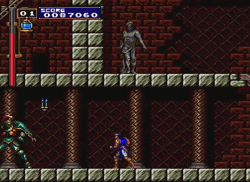 Actually, let’s go ahead and aim for the highest end of the bummer scale: Castlevania: Rondo of Blood being tied to the Japanese exclusive PC Engine CD was a mega bummer. Castlevania: RoB is a pleasure to play, and it is a game that revels in the best of its NES ancestors while employing a controller with a very Famicom-esque 4-button setup. Two years after the experimentation of Simon Belmont’s 8-way whip and myriad of buttons in Super Castlevania, this is the franchise returning to its roots with jump, attack, and (generally) familiar sub weapons activated by holding up. The select button activates the new item crash ability, but, aside from that bit of heavy heart consumption, this is basic Belmonting back in action. And Castlevania is anxious to welcome its hero back with open (skeleton) arms, as all of the stages are pure Castlevania goodness built exactly for a man that jumps rigidly and whips even… uh… rigider. In truth, Richter Belmont is slightly more nimble than his less acrobatic ancestors, and Castlevania has learned how to adapt. He might not yet have a slide or rising uppercut, but he does have a backflip, and many a monster now has a pattern that is perfectly dodge-able with this unique version of the double jump. In short, like Trevor and Simon before him, Richter is facing challenges that are perfectly calibrated to his exact moveset. Unlike many (many, many, many) action platformers of the time, Castlevania: Rondo of Blood was made with precision and care.
Actually, let’s go ahead and aim for the highest end of the bummer scale: Castlevania: Rondo of Blood being tied to the Japanese exclusive PC Engine CD was a mega bummer. Castlevania: RoB is a pleasure to play, and it is a game that revels in the best of its NES ancestors while employing a controller with a very Famicom-esque 4-button setup. Two years after the experimentation of Simon Belmont’s 8-way whip and myriad of buttons in Super Castlevania, this is the franchise returning to its roots with jump, attack, and (generally) familiar sub weapons activated by holding up. The select button activates the new item crash ability, but, aside from that bit of heavy heart consumption, this is basic Belmonting back in action. And Castlevania is anxious to welcome its hero back with open (skeleton) arms, as all of the stages are pure Castlevania goodness built exactly for a man that jumps rigidly and whips even… uh… rigider. In truth, Richter Belmont is slightly more nimble than his less acrobatic ancestors, and Castlevania has learned how to adapt. He might not yet have a slide or rising uppercut, but he does have a backflip, and many a monster now has a pattern that is perfectly dodge-able with this unique version of the double jump. In short, like Trevor and Simon before him, Richter is facing challenges that are perfectly calibrated to his exact moveset. Unlike many (many, many, many) action platformers of the time, Castlevania: Rondo of Blood was made with precision and care.
But there’s more to Castlevania: Rondo of Blood in the “care” department. Case in point: Richter, as part of the animated introductory sequence, looking over this old map left to him by his ancestors:
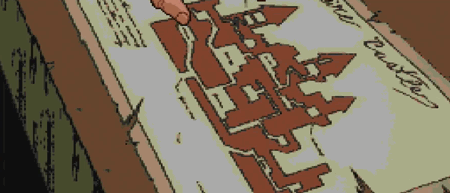
I know that map! That looks like the map from Castlevania 1! Right there in the intro! This game knows Castlevania! That game I played!
And there are innumerable other overt Castlevania references throughout the game. The first level takes place in a burning town that is straight out of Castlevania 2. Richter and Maria become partners with a handshake that evokes the partners of yore. Shaft summons a legion of monsters that match the bosses of Castlevania 1. A ferryman promises to take you somewhere good, and a certain familiar mask breaks apart to reveal your opponent. Over and over, Castlevania: RoB practically shouts adulations about its exalted ancestors, and, if you’re on the same page, you’ll be shouting with glee in unison. Did you see that main hall with all the zombies? Leading to the giant bat’s decomposing arena? That’s some good Castlevaniaing right there!
But… to what end? Does Castlevania: Rondo of Blood need all these references to past titles?
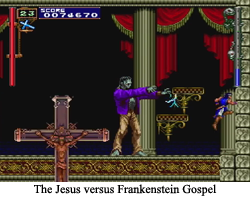 Consider Rondo of Blood’s place in the Castlevania canon at its release. It was, effectively, the fourth Castlevania game. There were the portable adventures, but, at the time, the Gameboy was considered “less than” its console big brothers, and Christopher Belmont was nary worth a second glance. Super Castlevania was an amazing game, but it was a “retelling” of Simon’s journey, and nearly all of its innovations were dropped for Rondo (and other future titles). And Haunted Castle? The arcade game? Let’s go ahead and label that as mythical as Akumajou Dracula X68000. So, yes, while it might not be a technically accurate way of labeling the game, Rondo of Blood is, at least in spirit, the fourth Castlevania title. Simon Belmont’s initial quest, Simon Belmont’s horrible night to have a curse, Trevor Belmont’s big ol’ vampire party, and now Richter Belmont’s time to shine. It’s a pretty straight line across the franchise there, and blatantly calling attention to your forbearers doesn’t seem all that essential at a time when Mario or Link would practically toss their entire canon for their latest game (Mario is…. let’s say he’s a baby this time, and he was raised by dinosaurs). Seven years is all that separated Castlevania 1 and this quasi Castlevania 4 (maybe 5? Maybe… 9?), so why revel in the past when the past was barely even passed?
Consider Rondo of Blood’s place in the Castlevania canon at its release. It was, effectively, the fourth Castlevania game. There were the portable adventures, but, at the time, the Gameboy was considered “less than” its console big brothers, and Christopher Belmont was nary worth a second glance. Super Castlevania was an amazing game, but it was a “retelling” of Simon’s journey, and nearly all of its innovations were dropped for Rondo (and other future titles). And Haunted Castle? The arcade game? Let’s go ahead and label that as mythical as Akumajou Dracula X68000. So, yes, while it might not be a technically accurate way of labeling the game, Rondo of Blood is, at least in spirit, the fourth Castlevania title. Simon Belmont’s initial quest, Simon Belmont’s horrible night to have a curse, Trevor Belmont’s big ol’ vampire party, and now Richter Belmont’s time to shine. It’s a pretty straight line across the franchise there, and blatantly calling attention to your forbearers doesn’t seem all that essential at a time when Mario or Link would practically toss their entire canon for their latest game (Mario is…. let’s say he’s a baby this time, and he was raised by dinosaurs). Seven years is all that separated Castlevania 1 and this quasi Castlevania 4 (maybe 5? Maybe… 9?), so why revel in the past when the past was barely even passed?
Well, if pressed, let’s blame this gal:
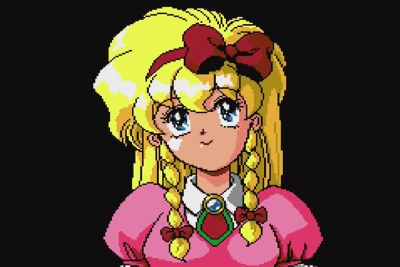
Maria is a departure for the Castlevania franchise. History may not have always been Belmonts fighting Dracula, but this is certainly the first time the Prince of Darkness had to deal with a girl hurling doves at his face. Maria is supposedly twelve but acts like she’s five, wears a pink, frilly dress, and occasionally summons a kitten to fight her battles. For a franchise that often touts itself as “gothic horror”, Maria is an aberration like no other. Sypha was a serious magician that deliberately hid her gender to succeed in the male-dominated field of vampire-slaying, Maria is going to sing off-key at an army of golems on her way to “the bad man”. Graphically or tonally, Maria is something the Castlevania franchise has never seen before.
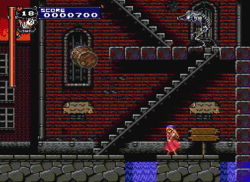 But even beyond her heavy dosage of shocking pink, Maria is a whole new animal for the Castlevania franchise in a different way. Both Maria’s offenses and her acrobatics completely alter the flow of RoB. There had been more nimble characters in Castlevania before, but Grant never had the ability to rapid-fire a boss into submission, and Alucard’s bat-like maneuvering cost more hearts than it ever gained. Give or take the greater fragility of youth (Richter has learned how to take a hit over the years), Maria is better than Richter in every way that matters. She can mass-murder medusas en masse, and then double jump up a staircase to find a bonus shortcut. There are entire stages that can be outright skipped with her absurd mobility while Richter is stuck fighting that damned naked werewolf yet again. It’s easy to say Maria “breaks the game”, adding a sort of “easy mode” to a franchise that previously was celebrated for its technical difficulty.
But even beyond her heavy dosage of shocking pink, Maria is a whole new animal for the Castlevania franchise in a different way. Both Maria’s offenses and her acrobatics completely alter the flow of RoB. There had been more nimble characters in Castlevania before, but Grant never had the ability to rapid-fire a boss into submission, and Alucard’s bat-like maneuvering cost more hearts than it ever gained. Give or take the greater fragility of youth (Richter has learned how to take a hit over the years), Maria is better than Richter in every way that matters. She can mass-murder medusas en masse, and then double jump up a staircase to find a bonus shortcut. There are entire stages that can be outright skipped with her absurd mobility while Richter is stuck fighting that damned naked werewolf yet again. It’s easy to say Maria “breaks the game”, adding a sort of “easy mode” to a franchise that previously was celebrated for its technical difficulty.
But that’s cool, because Rondo of Blood earned this easy mode.
In some lesser version of Rondo of Blood, Maria would likely come off as some manner of Zero in Mega Man X4 situation: this game was made for Maria Renard, and Richter is only there because the director decided to throw the “old fans” a bone (“I guess it is his franchise… I guess…”). But, no, it is clear from every carefully placed block, pit, and enemy that this is a game made for a Belmont. This is a Castlevania adventure like any other, and a malicious mummy is no mere Family Guy-esque shallow “reference”, it is a pact with the player that this is the real deal. Yes, there’s a little girl over there that can completely tear Shaft a new one, but she’s just an option, not the star. Richter is the hero. Richter is the guy that can backflip away from a fireball, and he’s the hunter that is going to be responsible for Death’s dental bills.
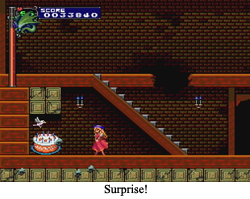 Castlevania: Rondo of Blood knows what’s up, and uses that knowledge to slide in a few perversions to the Castlevania formula. This is a game that knows its past and present, and, as a result, defined the franchise for the future. C: RoB is a game that was created with perfect precision.
Castlevania: Rondo of Blood knows what’s up, and uses that knowledge to slide in a few perversions to the Castlevania formula. This is a game that knows its past and present, and, as a result, defined the franchise for the future. C: RoB is a game that was created with perfect precision.
… And if you want to see a version of Rondo of Blood that completely lacked that meticulousness…
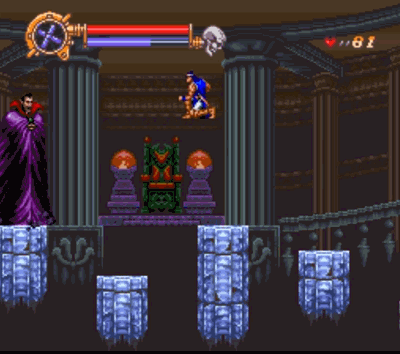
Well, the Super Nintendo “version” is right there. And let us never speak of that square ever again.
FGC #515 Castlevania: Rondo of Blood
- System: I understand there was once some manner of system called a PC Engine CD? Sounds… unholy. But this is available as part of the PSP Castlevania: The Dracula X Chronicles (though forbidden on the Vita TV), on the Playstation 4 Castlevania compilation (but not the other Castlevania compilation), the Nintendo Wii when that storefront was available, and now on the Turbo-Grafix 16 Mini. Play it on the mini. It has the controller this was always meant for.
- Number of players: Richter or Maria, you can still only do it alone.
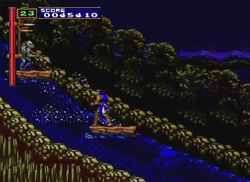 Port-o-Call: The PSP remake, Castlevania: The Dracula X Chronicles, certainly brings the game into the 21st Century, but it seems to unnecessarily suck all the candy-colored joy out of the game. I can understand why this was done (Castlevania is a very serious franchise for very serious people that eat meat out of walls), but it squashes a healthy amount of the original’s charm. Or, put another way, Maria is wearing pants now. Just let the girl be her anachronistic self!
Port-o-Call: The PSP remake, Castlevania: The Dracula X Chronicles, certainly brings the game into the 21st Century, but it seems to unnecessarily suck all the candy-colored joy out of the game. I can understand why this was done (Castlevania is a very serious franchise for very serious people that eat meat out of walls), but it squashes a healthy amount of the original’s charm. Or, put another way, Maria is wearing pants now. Just let the girl be her anachronistic self!- What’s that sound? The original has some seriously weird sound effects. Like, “sound of a buffalo farting out pre-digested wheatgrass” weird sound effects. They happen constantly. I am loving it.
- Favorite Boss: Undead Shaft is a hoot. Please keep summoning bosses I already defeated! I love being reminded of earlier areas by being assaulted by rotting dragon flesh. … Wait, does this mean Rondo contains references to its own, immediate past? Hm.
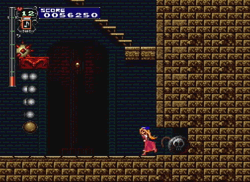 Did you know? Koji Igarashi has stated in interviews that Castlevania: Rondo of Blood and Castlevania 3 are his two favorite Castlevania games. Well duh.
Did you know? Koji Igarashi has stated in interviews that Castlevania: Rondo of Blood and Castlevania 3 are his two favorite Castlevania games. Well duh.- Would I play again: In a skeleton’s heartbeat. Wait… Uh… Can I just say yes? This is one of the best Castlevania games out there, and it justifies the TG-16 Mini all on its own. Bedrock of the Castlevania franchise, and certainly worth another play.
What’s next? Random ROB has chosen… Celeste! It’s about the climb! Please look forward to it!
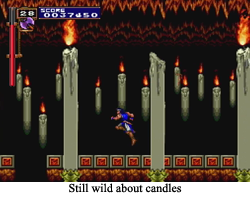
I’m glad I first experienced Rondo of Blood on the Wii VC, ‘cuz Dracula X Chronicles does not do justice to the game at all.
The remake is too uncanny valley (my favorite moment is the one brief close-up in Stage 3* where Richter’s hair looks like it took a poop on his head) and loses the cool animated cutscenes in favor of the boring bland models, while the PSP port of the original game is blurry and buggy and loses the sound fadeout.
By comparison the unlockable SotN port is much better, but it’s a shame there’s no option for the original dub or proper proportions.
Shame there hasn’t been a Castlevania Collection 2. Rondo and Symphony should really be on Switch and they both deserve better than PS4 adaptations of the PSP ports.
[…] release of the TurboGrafx-16 Mini offered me my first opportunity to play Castlevania: Rondo of Blood on something approaching “original” hardware. I had conquered Richter’s Big Adventure through […]
[…] not universal) boss in the Castlevania franchise, and then graduated to more of a presence in Castlevania: Rondo of Blood with his first turn as a “tutorial” boss. Then, in its direct sequel, Symphony of the Night, […]
[…] ending when the final battle against Red is a 3-D recreation of the terrible final Dracula fight of Castlevania X? Teleportation and small platforms do not mix on a good day, but please do not also combine that […]
[…] case scenario for all of them is the opportunity to probably not be run out of town on a cross. Maria might be the sole exception to this rule in Castlevania, as she openly and loudly volunteers for […]